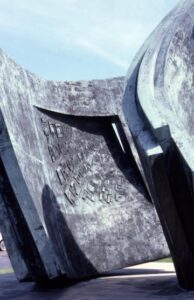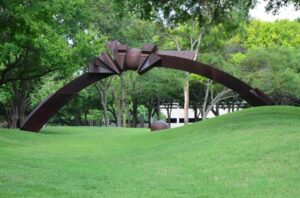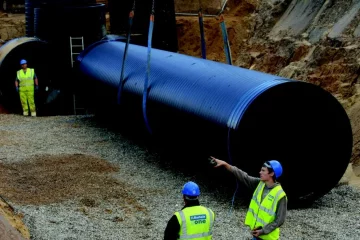“What ties us all together is a need for some connection with realism “
- John Vassar House
Throughout history, sculptors have been essential in forming and maintaining the cultural fabric of their civilizations. The importance of sculptors—especially those who work outdoors—is timeless since their works serve as palpable examples of human expression and ingenuity. Outdoor sculptures have graced public areas since the dawn of civilization, acting as symbols of historical occurrences, cultural identity, and creative ingenuity. Sculptures are resilient and have a significant impact on communities because of their enduring nature, which is a result of their exposure to the weather and the passage of time.

“The three-ton sculpture is composed of simple powerful multiple sheets, curved with space enough to walk between. When one enters the passageway between the forms, the eye is led to a Table of Elements forming a sharply converging pattern of diminishing symbols leading the eye out to a slit that completely pierces the bronze. The slit, with light coming through, implies infinity.”
1968 – Table of Elements sculpture for Hooker Chemical Corp. Research Center on Grand Island New York
John Vassar House stands out in this illustrious heritage and makes a lasting contribution to the history of outdoor art. House, who was born in Niagara Falls, New York, on February 19, 1926, had a career spanning several decades that displayed a variety of styles and mediums, demonstrating his adaptability and artistic development in bronze forms. But what really makes him unique is his contribution to outdoor sculpture, which places him in the long tradition of artists who have made an effort to enhance public areas through their works.
In the art world, outdoor sculptors occupy a special place because of the way their creations engage the surrounding landscape’s rhythms and natural elements. As a result of this connection, sculptures become essential elements of the public sphere, fostering reflection and conversation and changing the viewing experience. The ability of outdoor sculptors such as John Vassar House to improve the cultural and communal fabric of the places they occupy, in addition to the works’ aesthetic value, is what leaves a lasting impact.

“In these waters October 12, 1492, Columbus dropped anchor”
1972 – underwater marker with inscription San Salvador Island Bahamas
Photo courtesy Alex Mustard 2014
A turning point in John Vassar House’s career came when he chose to locate his studio in Rome, Italy, in 1957. The rich historical and cultural legacy of Rome served as a backdrop for House’s investigation of many sculptural phases, ranging from welded sculptures and reliefs to the organic motifs of “Pods, Seeds, Birth.” His outdoor sculptures, which range in subject from figurative to abstract, have been placed in public areas, private collections, and esteemed organizations in several nations, including Italy and the United States.
Notably, outdoor sculptures have the ability to create a universal connection through shared artistic experiences that can transcend geographical borders. Exemplifying the grandeur and ambition frequently associated with outdoor sculpture are House’s huge bronze and steel projects, such as the “Table of Elements” in Grand Island NY, “Sun Up at Quorum” in Dallas and the “Underwater marker” for the 500th anniversary of Columbus’s anchorage in the Bahamas.

“Twice a year, the sun will strike the unique piece at a precise angle to direct a shaft of sunlight through an aperture projecting an “X” onto a metal sphere embedded in the ground.”
“The sculpture consists of an arch that compresses seven wedges, representing the visible planets and a partial sphere, representing the sun, above a second sphere below, the moon.”
1981- Sun Up at Quorum North Dallas (Addison) Texas
Urban areas’ cultural identity is enhanced by outdoor sculptures, which frequently become essential components of cityscapes. House has left a lasting impression on public areas with his broad body of work, which includes architectural projects and memorial bronzes. This is a testament to his dedication to both artistic expression and cultural enrichment.
As we reflect on the legacy of John Vassar House, we recognize the enduring significance of outdoor sculptors in shaping our shared environments and cultural narratives. His commitment to pushing creative boundaries, his diverse sculptural phases, and his ability to create works that resonate across borders contribute to the lasting impact of his legacy in the world of outdoor sculpture. John Vassar House stands as a testament to the transformative power of art in public spaces, leaving a legacy that continues to inspire and engage audiences worldwide.





